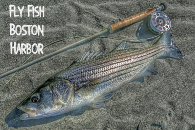Small flies for selective trout-midges, ants, PT's... The largest fly pictured is a size 22 Pheasant Tail.
Tuesday, December 25, 2007
Small Flies
Small flies for selective trout-midges, ants, PT's... The largest fly pictured is a size 22 Pheasant Tail.
Monday, December 24, 2007
Happy Holidays!!!
Tuesday, December 18, 2007
Pink Bear Trout Streamer
Saturday, December 15, 2007
Holmfridur Streamer
I found out about this Icelandic streamer in 1991, and it has found a place in my fly box ever since. It is a great warmwater and coldwater streamer, and a super easy fly to tie.
Body: No body! Instead, tie a small bulb of red tying silk or estaz (pictured) to help offset the wing;
Wing: Brown over yellow marabou;
Beard: Red or orange hackle fibers mixed with flashabou.
Thursday, December 13, 2007
Woodcock Feathers
The wing feathers of European Woodcock (Scolopax rusticola) have a stunning combination of brown, rust, tan and grey tones. Known for centuries as a traditional fly tying material, they are somewhat similar to snipe covert feathers. They are indispensable for classic wet flies, but can also be useful for various dries and emergers. I've been playing around with several variations on the familiar theme (see previous blog entries)...
Woodcock & CDC Flymph
Tail: Lemon wood duck
Body: Wrapped CDC feather
Collar: Woodcock covert feather
Soggy CDC Caddis (Freshly Hatched Caddis)
Body: Cream opossum
Wing: Ginger CDC
Support hackle: Grizzly-brown rooster, clipped on the bottom
Front hackle: Woodcock covert feather (single turn), slightly oversized
Monday, December 10, 2007
March Brown Dry (Triple Hackle)
Wednesday, December 05, 2007
Waterhen Soft Hackles
Feathers of water birds are fascinating... I have just received some waterhen (moorhen, Gallinula chloropus) feathers. The close up shows beautiful olive colored covert feathers, while feathers found under wings are drab grey. The texture of barbules is superb for both wet and emerging dry soft hackles.
Waterhen Bloa (traditional)
Body: Yellow silk dusted with mole dubbing
Wing: Grey feather from under wing of waterhen
Large Olive Soggy Dun (V. M.)
Tail: Microfibetts
Body: Olive silk dusted with mole dubbing
Support dry hackle: Badger clipped on the bottom
Front hackle: Waterhen olive covert feather tied in reverse
Subscribe to:
Posts (Atom)



